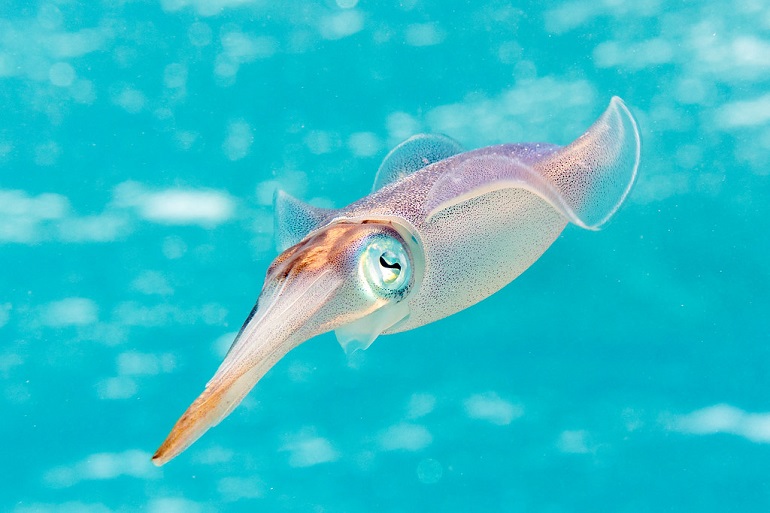Squids have long been associated with sea monsters and old sailors’ tales of the deep. These amazing creatures inhabit oceans all around the world, from the deepest and coldest Antarctic to the tropical warmth of equatorial waters.
They play a critical role in the ecosystem of our seas. They also have incredible, almost alien, biology that makes them quite unlike any other living thing!
Read on to find out all you ever wanted to know about these mysterious marine creatures!
Squid Classification
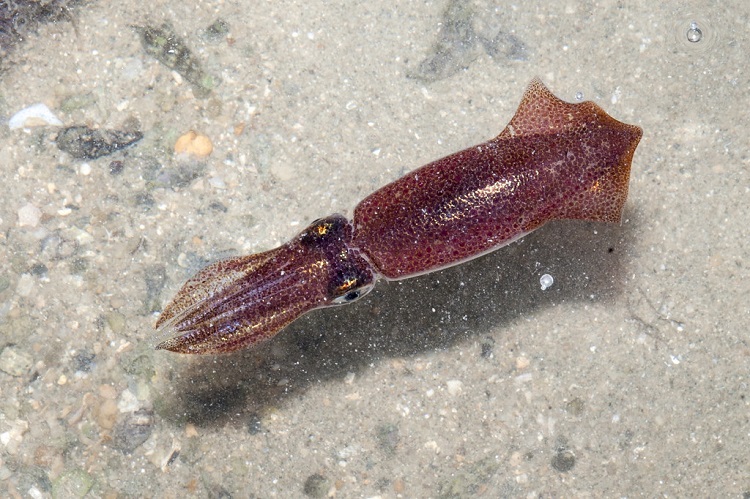
All squids belong to the kingdom “Animalia.” Creatures in this kingdom are multicellular and consume other living things for nourishment.
Within this kingdom, squids are members of a phylum called “Mollusca.” This phylum includes as many as 200,000 other species, such as scallops and slugs.
Squids are listed in the taxonomic class called “Cephalapoda.” Cephalopods are predatory mollusks that can also be cannibalistic.
Squid Evolution
Squids are believed to have evolved about 60 million years ago. There is evidence of their evolutionary history in other mollusks.
Many mollusks have what is called a radula in the rear of their oral cavity. This is used to help them grind up food. Giant squids also have a cartilage-like backplate which provides rigidity to their bodies. This is a remnant of their shelled ancestors.
Close cousins of the squid, such as cuttlefish and nautilus, also have this structure, which proves they are distantly related.
Squid Species
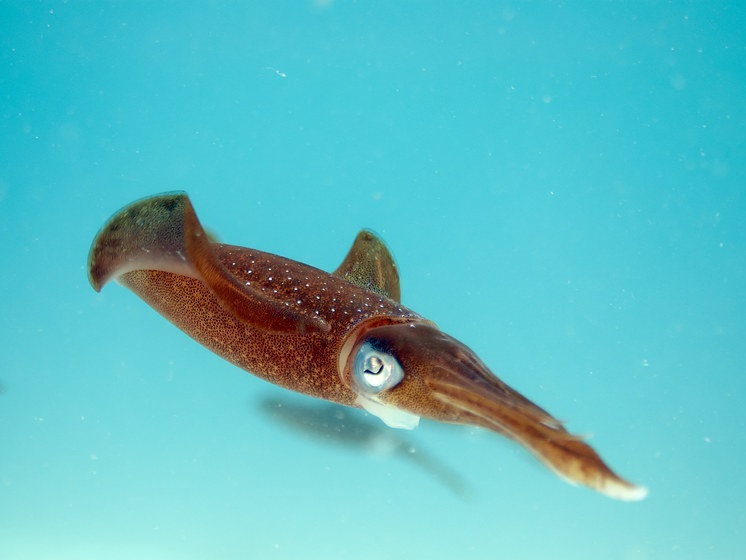
There are over 300 species of squid that have so far been discovered. Each species falls into one of two orders: Myopsida or Oegopsida. Squids in the order Oegopsida have eyelids, while those in Myopsida do not.
Colossal Squid
The Colossal squid is the biggest invertebrate on the planet. This creature has the largest eyes of any known living thing, so it can see prey in the dark ocean depths. It can reach up to 46 feet long and weigh as much as 1100 pounds.
Giant Squid
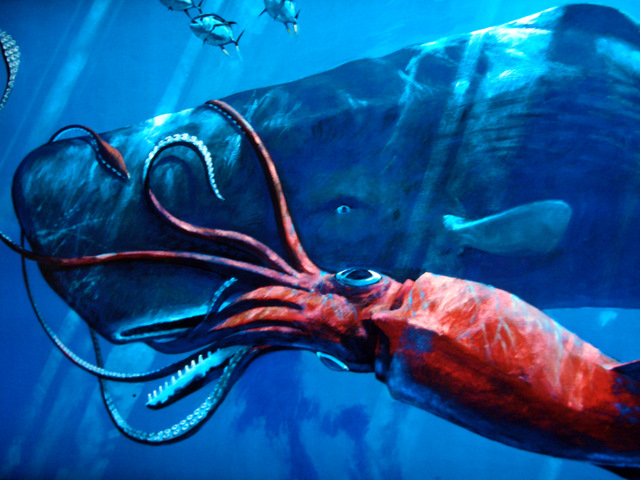
As their name suggests, this species is very large. Female Giant squids can be around 10 feet longer than males. This squid is actually longer than the Colossal squid, capable of reaching 60 feet long! However, it is slimmer and weighs about half as much as a Colossal squid.
Humboldt Squid
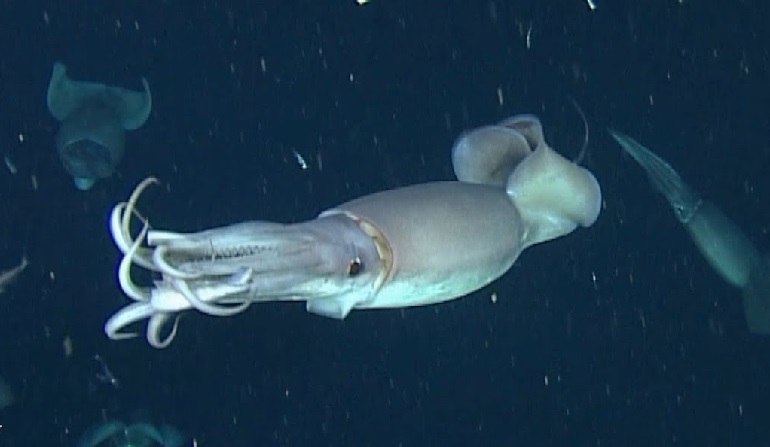
Sometimes known as the Jumbo squid or Flying squid, this species usually lives in the balmy waters of the Pacific Ocean all the way up to the fringes of Alaska. They travel in large shoals of around 1,200 individuals and are aggressive predators.
Vampire Squid
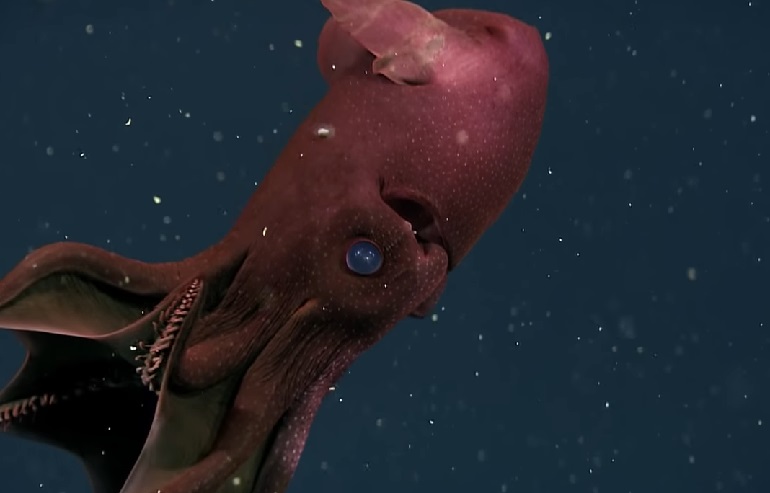
Nope, this squid isn’t a bloodsucker. But they do have some vampire-like qualities! They are dark red/black in color and have webbing between their tentacles. As they float in the water, it looks like they have a cape – which explains their ghoulish name.
Squid Population
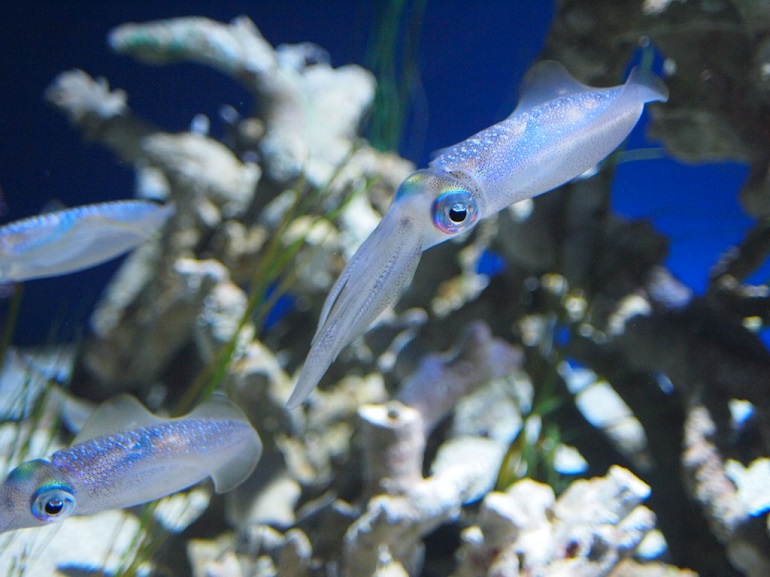
The total squid population is impossible to know, but it is likely to be in the millions.
Squids are incredibly important to the ecosystem. They are an important food source for many marine mammals and also work to transport nutrients and carbon across ocean systems.
The IUCN has designated Colossal squid as the ‘least concern”. This means that they are not considered to be endangered or threatened.
What Does a Squid Look Like?
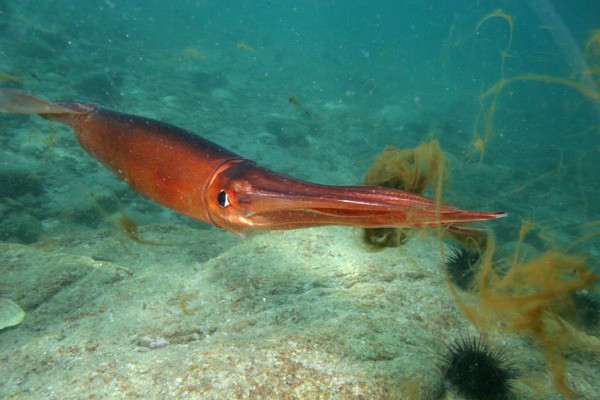
Squid species can appear very different from each other. However, they all tend to share certain similarities. For example, they usually have a long, tube-like body (called a mantle) and flattened heads.
On each side of the mantle, they have fins. This help to move them through the ocean depths. Their fins can be pretty large. Some species have fins that run the entire length of their bodies.
Adult Giant squid also has very large eyes positioned on each side of their heads. This gives them a 360-degree vision to look out for predators and prey. It is said that a Giant squid’s eye is as big as a frisbee!
Their arms and tentacles are located at the bottom end of their bodies but attached to their heads. Both the arms and tentacles are covered with suckers, and sometimes sharp little hooks, so they can grab hold of prey.
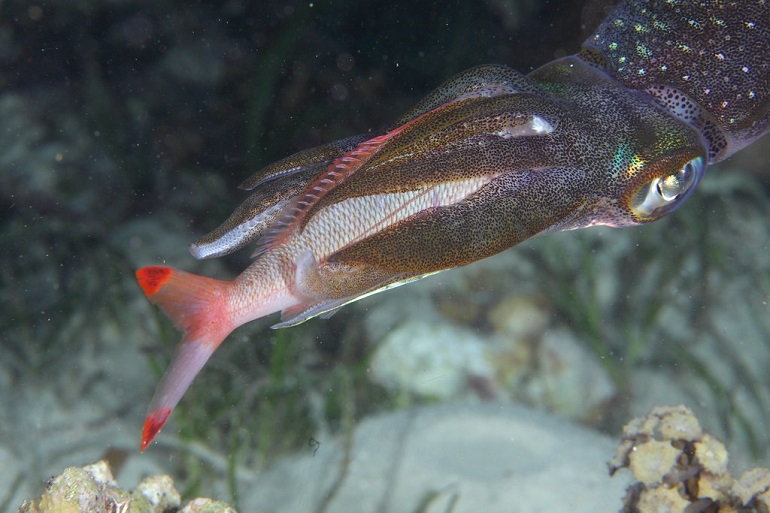
Squids don’t have a full skeleton. Instead, they have a small internal support structure that is made from “chitin.” This is almost like an internal shell to maintain their shape.
Many squids are able to change their color to camouflage themselves or signal other individuals. However, when they are relaxed, most squids are gray, brown, white, or black. Some deep-sea squids also have bioluminescent organs.
The heaviest adult squid ever recorded was a Colossal squid caught by a New Zealand fisherman in Antarctic waters. It was found in 2007 and weighed close to 1,000 pounds.
The smallest squid is the Southern Pygmy Squid, which is only ¾ inch big!
Where do Squids Live?
Squids inhabit oceans all around the globe. Different types prefer different depths and temperatures, though. Some like to live in tropical waters, but others are happier in icy cold seas such as the freezing Antarctic depths.
Squids are free-swimmers, so they do not have one place they call home. They will move around hunting for food and avoiding predators, although many do like to stay fairly close to the sea floor.
Development and Behavior
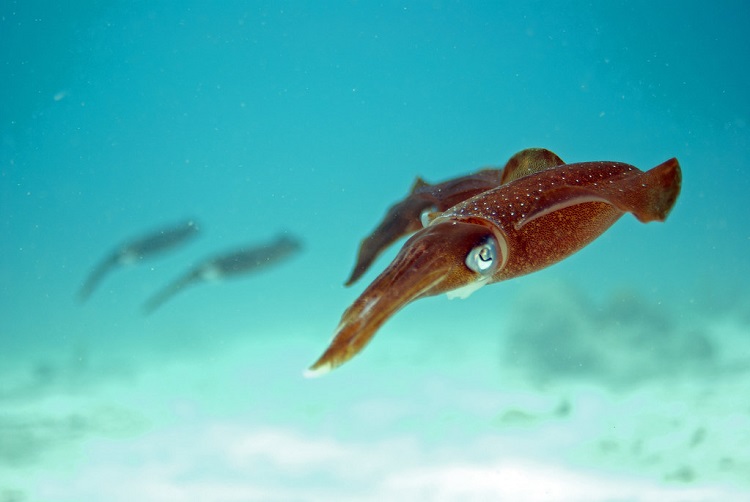
Squids are usually solo animals, but they have been known to gather together with others in groups. Sometimes, they will even hunt cooperatively, just like wolves do. A pack of squid is called a squad, shoal, or school.
The unique shape of a squid’s body helps it to glide quickly through the ocean. They mainly use the fin to swim, but they can also suck in water and spit it out to jet-propel themselves in an emergency. When threatened, many squids will also squirt ink clouds to hide themselves as they escape
Squids are carnivorous creatures, mostly eating fish, shrimp, crabs, and oysters. They are also cannibalistic – so they will kill and eat another squid if needed.
They grab prey with their long tentacles and grasp hold of it with their sticky arms. Their super sharp beak then chomps into the flesh, cutting it up into bite-sized chunks.
As there are so many types of squid, there is variation in their lifespan and reproduction methods. Usually, a male squid will attach its sperm to the body of a female, and she will use it later to fertilize her eggs.
The female squid lays her eggs by attaching them to seaweed or burying them in the sand on the ocean floor. Mother squids don’t take care of their babies. Once the eggs are laid, she will leave and never come back.
After hatching, the tiny squids are called paralarvae. They use the yolk of the egg to sustain themselves at first until they are big enough to hunt for themselves.
Experts aren’t sure exactly how long a squid can live, but most people think that they live for about 5-years or less in the wild. That said, very large species, like the Colossal squid, could live for as long as 15 years.
Squid Characteristics
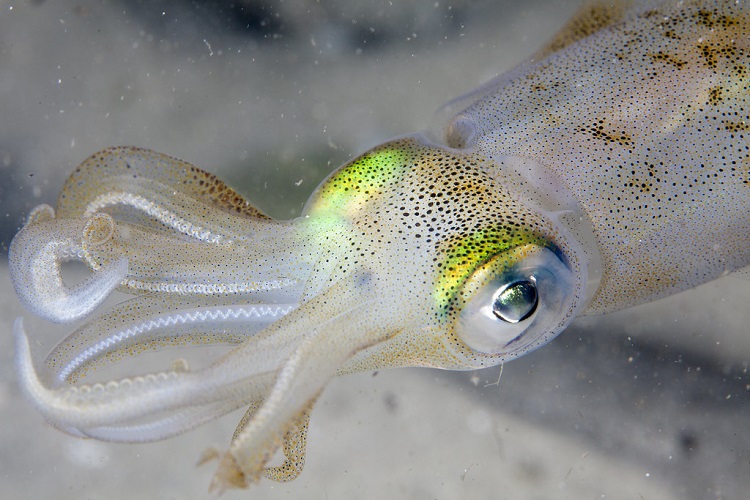
Below are some interesting squid characteristics.
Escaping Predators
Squids are very adept at escaping predators.
They have a muscular bag inside them that is filled with concentrated melanin. When they are threatened, they expel this melanin liquid, creating a sticky cloud of “ink” that confuses the predator and gives them a chance to escape.
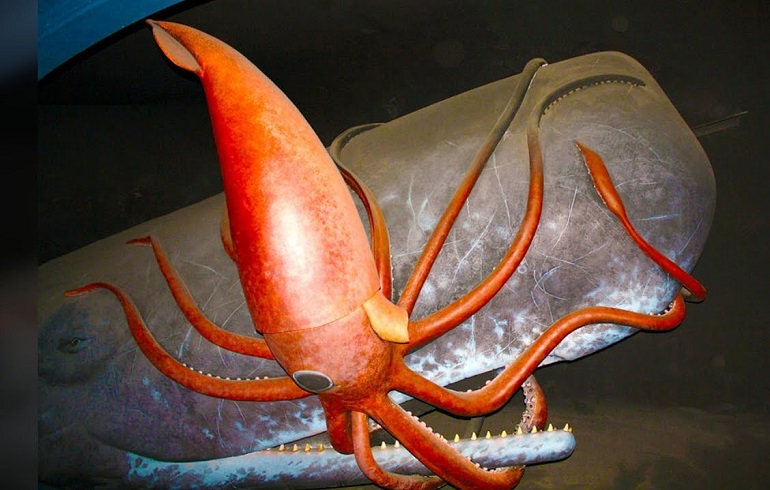
Some other squids will hook their arms into the flesh of their enemy and then sever their own limb, leaving it wiggling around attached to the predator. As you can imagine, this technique is a very effective distraction!
Intelligence
Giant squids are believed to be a bit less intelligent than their brainy octopus cousins, but they certainly aren’t stupid creatures.
They can display amazing social signaling, and many experts believe they are as smart as dogs. In captivity, squids like to have things to play with to keep their minds occupied.
Squid Nervous System
In biology, an axon is a very thin, cable-like structure that connects neurons for electrical signal transmission. In people, axons are many times thinner than human hair.
Giant squids have what is called a “giant axon,” which is about 1mm thick and up to 1 meter long. It’s used to coordinate the muscle movement that propels the squid through the water.
The nervous system of deep-sea squids is one of the most complex known to man and has been studied by scientists for many years.
Reproductive and Digestive System
Male squids inseminate a female by transferring their sperm packages to the exterior of the female’s body.
Depending on the species, female squid often has one or several receptacles around their arms. The male squid attaches his sperm parcel close to these receptacles, where the female will store the sperm until they are ready to conceive.
The exact mechanism of squid mating behavior is largely a mystery. Experts are still unsure how the female squid stores and transfers the sperm when she wants to reproduce.
When it comes to eating, giant squids also have an unusual digestive system. They don’t have any teeth, but they have a tough beak that breaks up their food. Most squids also have a rough tongue that helps to soften food and push it back toward their throat.
A giant squid’s esophagus runs right through its brains! These weird creatures have donut-shaped brains, so if they eat food that’s too large, they could damage their brain!
Once swallowed, squid digests its meal in a small stomach before it’s transferred to a larger caecum. Here, it is further digested, and all the important nutrients are absorbed.
When everything useful has been taken up, the remaining waste is moved into the intestines and turned into excrement. Squid poop out of the same hole that they use to squirt their ink, dispersing it out into the surrounding water.
Cardiovascular System
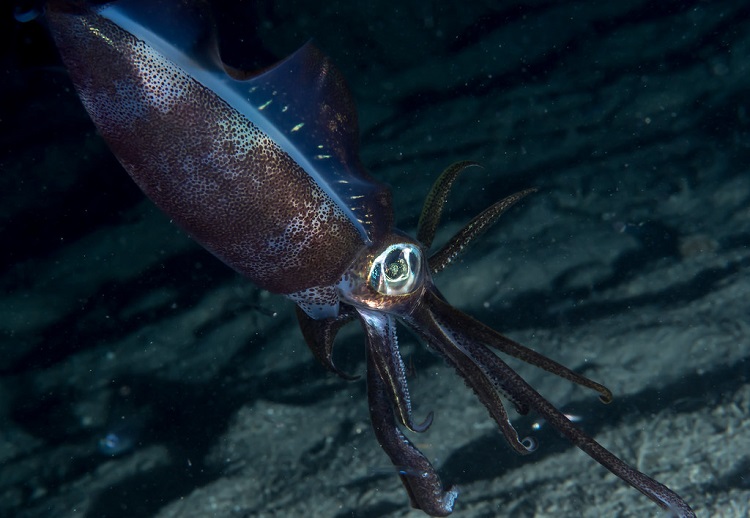
Squids also have an amazing cardiovascular system that includes three hearts! They have two branchial hearts and one systemic heart.
The branchial hearts pump their blood to the gills, where it absorbs oxygen from the surrounding water. This oxygenated blood then flows to the systemic heart, which pumps it around the rest of the body.
Giant squid blood is blue, not red. This is because their blood contains a copper-rich protein known as “hemocyanin.” This protein is effective at transporting oxygen in low temperatures and gives squid blood a dark blue color.
Buoyancy
Squids have a fluid-filled chamber that allows them to control their buoyancy. The heavy chemical density of seawater is replaced by low-weight ammonium ions created via the squids’ excretory system.
The mixture of these molecular weights enables the squid to maintain and control buoyancy as needed. It can adjust its weight so that it won’t sink to the bottom under strong depth pressures or float to the sea surface.
Unlike a fish swim bladder, which is filled with gas, the squid’s fluid-filled chamber isn’t affected by pressure changes at great depths.
Squid Facts
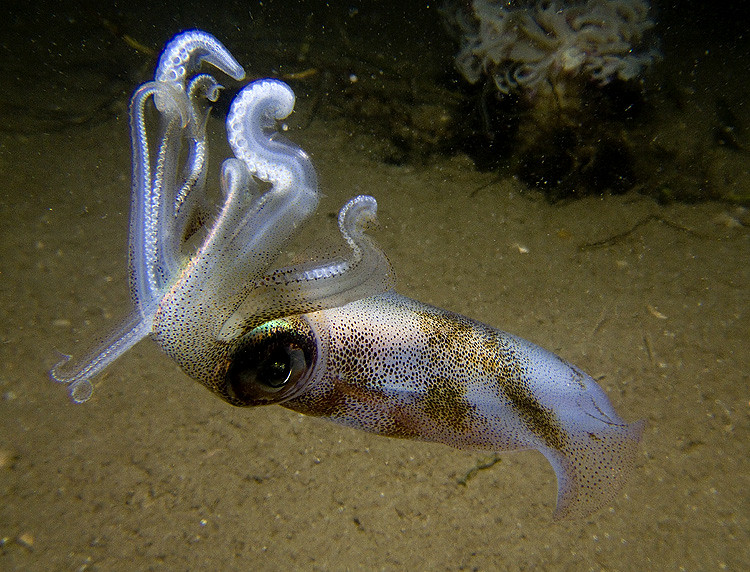
If you’re still not amazed by these super creatures, here are more cool facts for you.
Squids Have Amazing Camouflage Skills
Squid skin is covered with special cells called chromatophores. These cells enable the squid to make rapid changes to the color of its skin to match its surroundings. This helps them to avoid predators, almost like an invisibility cloak! They can also use this function for attracting prey.
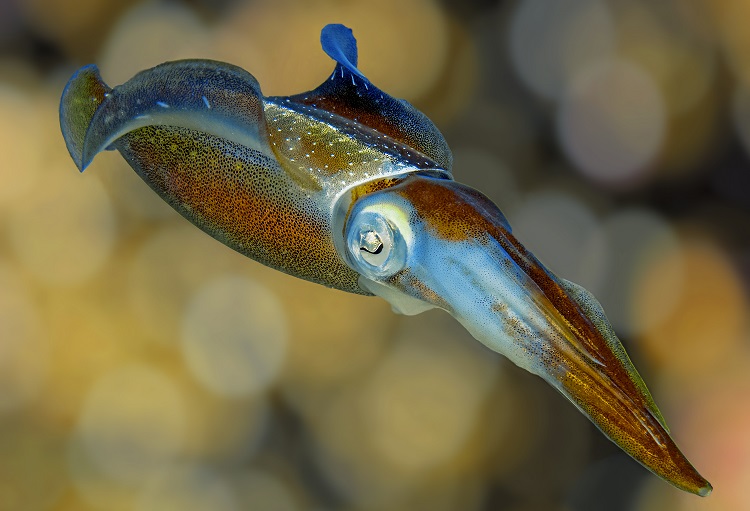
The underside of a squid is always lighter than the top, so they blend in with the light and darkness of the depths. This makes it more difficult for predators, and prey, to see them from above or below.
Some other squid species also display bioluminescence which lights up their bodies.
Their Suckers Leave Scars on Their Enemies
Giant squids are often attacked by sperm whales that will try to kill and eat them. The squid will put up a good fight, though. It uses its serrated suckers to tear into the whale’s flesh, leaving big, circular scars behind.
They Can Be Found in the Deepest Depth of the Ocean
Giant squids have been found living at incredible depths. Some squids inhabit depths of more than 4,000 meters where sunlight cannot reach them.
Threats to Survival
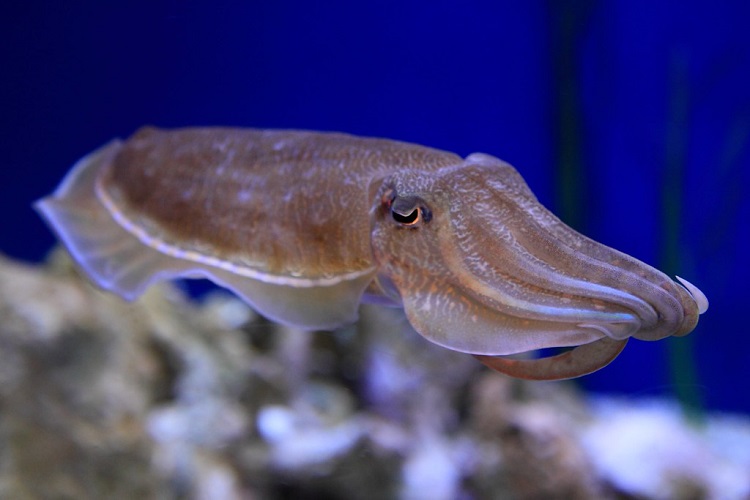
Because squids are found all throughout the world’s oceans, many sea creatures eat them. Their most common predators are whales, sharks, seals, penguins, and of course, humans.
Commercial fishing is also a threat to local squid populations – which we discuss in more detail below.
Human Uses
Given below is an overview of the relationship between humans and squids.
Importance in Art and Literature
Giant squids have been cast as bloodthirsty monsters of the deep for thousands of years. It’s believed that the Gorgon of Greek mythology was based on a large squid. The Gorgon’s head has a beak and lots of snake-like tentacles protruding from it.
The Nordic legend of the “Kraken” is likely to be based on sailors’ tales of encounters with these huge creatures. The famous 1870’s novel “Twenty Thousand Leagues Under the Sea” also mentioned a squid-like monster.
Squids as Food
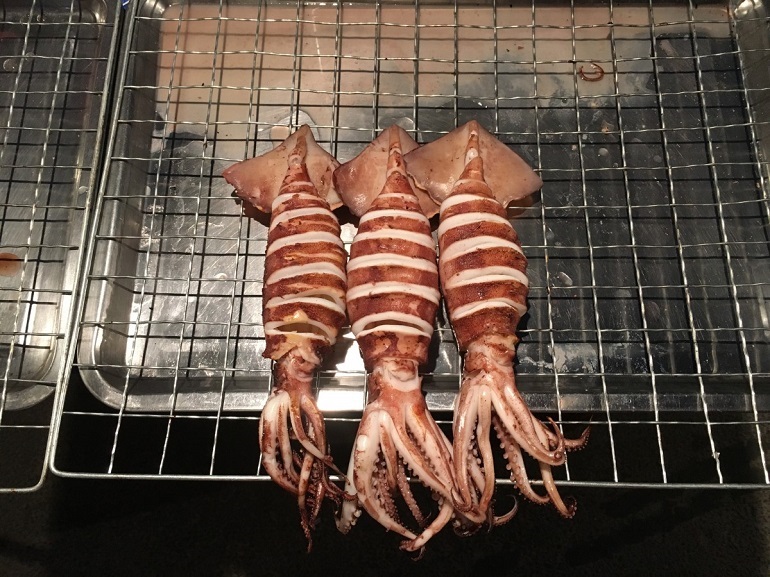
Squid is a popular food in many countries around the world, but it is particularly loved in Asia.
It is consumed regularly in Japan, often included as part of sushi dishes. It is also popular in Thailand and Vietnam, where it is often eaten dried or as part of a spicy salad.
In Western countries, squid is usually eaten as calamari, an Italian dish of rings of tentacles that are sliced or stuffed with other foods. They are often also fried, so they have a crispy coating.
Squid is quite a nutritious food that contains manganese, selenium, copper, zinc, and many other vitamins that are great for health. It is also low fat and high in protein, making it attractive for human consumption.
Commercial Fishing
The squid fishing industry has grown rapidly over recent years. It is now so prolific that it poses a real risk to ocean food webs.
Intense, unregulated fishing is threatening local squid populations, but there are currently no international regulations or monitoring in place to stop it. Therefore, squid boats can catch as much as they like without any government controls.
The demand for squid is very high, so the number of fishing boats heading out to make a catch has also risen. In the northwest Indian Ocean, there has been an 800% increase in jiggers over the last 5 years.
In some areas of the Atlantic, groups of around 500 ships will work together all night long, continually pulling large hauls of squid out of the ocean.
The jigger boats use lights to attract the squid closer to the surface. In some regions, there are so many boats together at one time that they can be seen from space!
In Innovative Scientific Applications
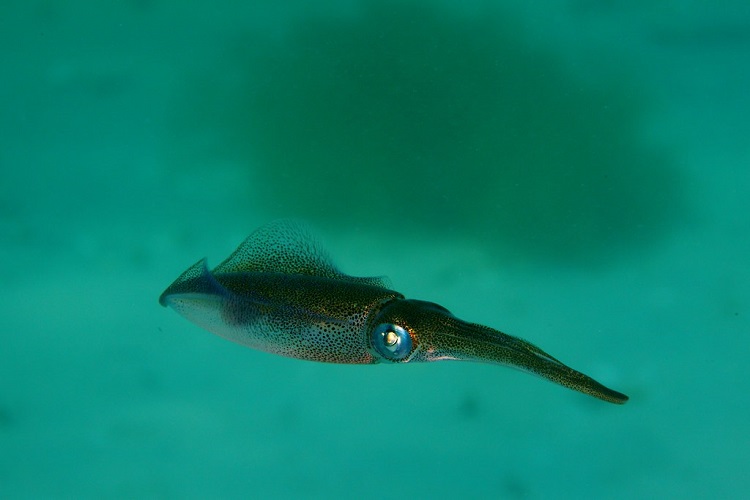
Cephalopods are no-doubt incredible creatures, but their unique biology is also useful to scientific research and development.
One of the most interesting recent projects involving squid is finding an alternative to plastic. Large companies, including Lego and Reebok, are keen to move away from oil-based plastic and instead use bioplastics in their products.
Scientists have found that a possible way to do this is to grow squid proteins in a lab environment. The protein found in the rings of squid tentacles is similar to that of silk. They are flexible, strong, and of course, water-resistant!
As this material can be recreated in a laboratory, there’s no need to kill any squid to make it. The artificial proteins can then be made into fibers, which could be used to create larger products.
At present, this type of protein is very expensive to produce. However, with the help of squid, there is now hope that we could attain a plastic-free future sometime soon!
FAQ’s
How Many Legs Does a Squid Have?
A squid has 10 limbs, but these are not all “legs”. Instead, they have two long tentacles and eight arms. The feeding tentacles only have suckers on the very ends, while the arms have suckers all the way along their length.
How Long Can a Squid Get?
The largest squid ever recorded had a total length of 43 meters. But it is very possible that squid can grow larger than this – we just have never seen them!
What Is the Scientific Name of Squid?
The squid scientific name will depend on the type. However, all squid are classified as cephalopods.
Are Squids Invertebrates?
Yes! In fact, they are the largest living invertebrates on Earth!
Conclusion
Squids are truly remarkable creatures. With more than 300 known species, squids range in size from the utterly tiny Southern Pygmy squid all the way up to the mammoth colossal squid. They inhabit the shallows and deepest depths of the world’s oceans and can change their appearance at will.
As both predator and prey, the giant squid is perfectly adapted to navigate dark open water. They squirt ink to confuse their enemies and use jet propulsion to shoot off into the abyss.
While these amazing cephalopods are not endangered, their populations are threatened by overfishing practices. You can help protect these marine marvels by spreading awareness of unsustainable fishing and campaigning for better regulation


